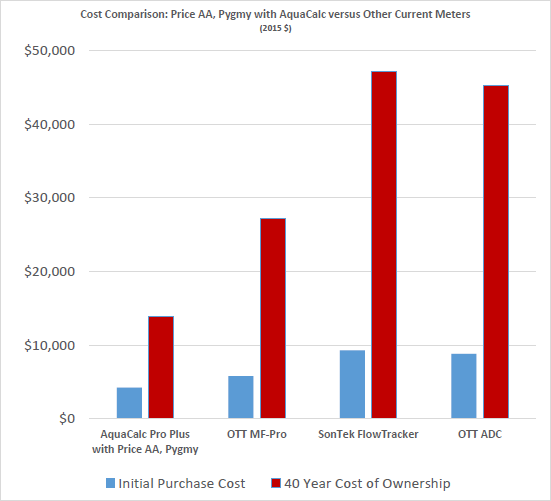 Loading... Please wait...
Loading... Please wait...Hydrological Equipment
NEWS RELEASE
Cost and Accuracy Comparisons

Mechanical Current Meter System with AquaCalc Versus Other Point Velocity Discharge Systems
Download PDF
Groundwater Monitoring
Groundwater is the water located beneath the earth's surface in soil pore spaces and in the fractures of rock formations. When rain falls to the ground, some of it is carried off as runoff down-slope into streams, lakes, and other bodies of water or into sewers. But some of it travels downward into the ground and through the underlying sediment, the upper part of which is not completely filled with water which is the "unsaturated zone." Continuing its downward route in the unsaturated zone it moves through the interconnected openings of sand, gravel, silt, and clay or openings in rock until it reaches the "saturated zone" where it becomes groundwater. The depth at which soil pore spaces or fractures and voids in rock become completely saturated with water is called the ground water table. Groundwater is recharged from, and eventually flows to, the surface naturally; natural discharge often occurs at springs and seeps, and can form oases or wetlands.
An aquifer is a layer of porous substrate that contains and transmits groundwater. When water can flow directly beneath the surface and the saturated zone of an aquifer, the aquifer is unconfined. The deeper parts of unconfined aquifers are usually more saturated since gravity causes water to flow downwards. A confined aquifer is an aquifer that is overlain by a relatively impermeable layer of rock or substrate such as an aquiclude or aquitard. If a confined aquifer follows a downward grade from its recharge zone, groundwater can be pressurized as it flows. This can create artesian wells that flow freely without the need of a pump and rise to a higher elevation than the static water table at the above, unconfined, aquifer. Groundwater is often cheaper, more convenient and less vulnerable to pollution than surface water. Therefore, it is commonly used for public water supplies. Groundwater provides the largest source of useable water storage in the United States. Underground reservoirs contain far more water than the capacity of all surface reservoirs and lakes, including the Great Lakes. Many municipal water supplies are derived solely from groundwater. Groundwater is often withdrawn for agricultural and industrial use by constructing and operating extraction wells. The study of the distribution and movement of groundwater is hydrogeology, also called groundwater hydrology.
Groundwater monitoring involves determining the quantity and quality of the groundwater and providing necessary instrumentation and testing to maintain the desired data collection requirements.
Water Level Monitoring
Well and borehole water levels are measured by water level meters which have either flat tape or coaxial cable marked so that as the probe is lowered down the well and touches the top of the water surface, it audibly signals the hydrologist and the depth from the top of the case to the water surface can be read off the tape. Also available are sonic meters which use sound waves that travel the depth of the well, bounce off the water level surface, and return to the meter which provides a depth reading on a digital display.
Another type of level instrument designed form longer term monitoring and automatic recording is the self-contained pressure transducer which can be programmed to record water levels as needed and can log for later retrieval or transmit continually through cellular, radio, or satellite communication.
Groundwater Sampling
Groundwater samples can be collected by bailing for quick spot checks in the field or pumping for longer term projects or where the volume required for testing makes bailing impractical. Bailers have different sizes depending on well size and volume required. Pumps depend on well depth and volume required and the contamination potential of submersible pumps compared to peristaltic pumps.
Groundwater Quality Testing
Groundwater quality can be tested from samples collected by bailers or pumps. These are then put in the appropriate sample container and then tested at the site or taken to the lab. Dedicated sampling systems or disposable equipment should be used for water quality testing based on the parameters and contaminants being tested for VOC's, DO, TDS, metals, etc. Also available are water quality testing instrumentation in-situ at the site or for transmission by cellular, radio, or satellite for internet website data reporting.
